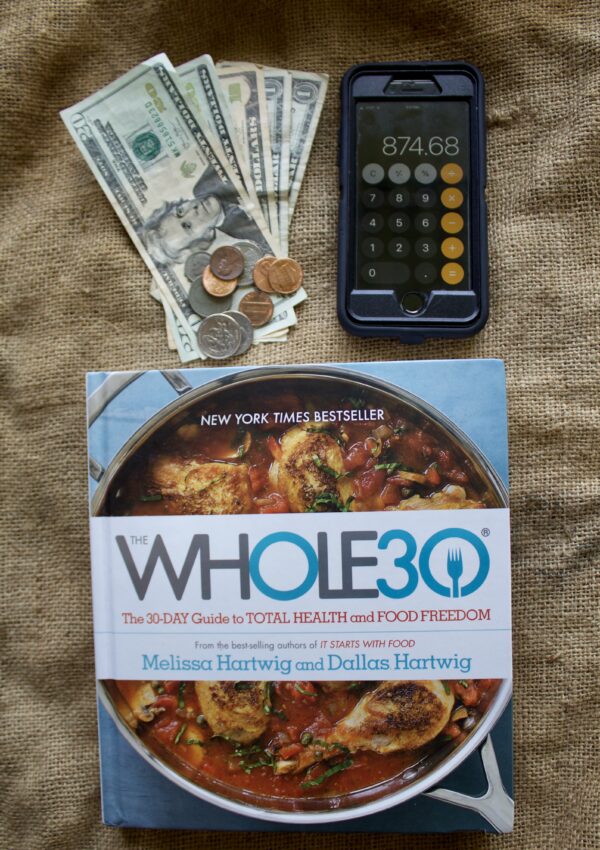The best way to track your spending is to actually track it. Doing the thing is a lot better than not doing the thing. Some might say the best thing.
Finding what works for you is the name of the game.
But first, a few questions.
- Do you prefer hands off and mostly automated?
- Do you thrive using paper products?
- Do you enjoy getting into the weeds of data?
HINT: keep reading to find out the pros and cons of the top ways to track spending.
The 3 best ways to track spending:
- Pen and paper
- Spreadsheets
- Money tracking apps
This list represents the heavy hitters of tracking spending.
Pen and Paper
There are two kinds of people in this world.
- The people who like to write on actual paper.
- And those who would rather do anything but–they’re more techy and prefer the speed of oh-so-sleek, technology.
Though using pen and paper can be a polarizing topic–you either love it or you hate it–we’ll start here because it is worth a review as the most basic and easy method of tracking spending.
Pros
1. Your Brain Likes Paper
Tracking spending with pen and paper creates a stronger relationship between your brain and the information you write.
An article in PsychologyToday.com reviewed some interesting findings to back this up in a study conducted in Tokyo in 2021 called “Paper Notebooks vs. Mobile Devices: Brain Activation Differences During Memory Retrieval.”
The study found that students using a pen and paper agenda to record complex personal schedules were:
- On average 3-4 minutes faster to record the information
- And more likely to recall the details of that information after some time had passed
Compare this to the students who used a phone or tablet to update a digital calendar for the exercise, who were slower to input the data and not as successful with memory recall when tested.
The study used a functional MRI (fMRI) to track brain activity during a Q&A session with each group of students one hour after they had captured the information.
It was found that the “analog” group that used pen and paper experienced more brain activity in more areas of the brain than the group that used the digital means of recording information. As a result, the analog paper group scored higher in terms of the details memorized.
How does this relate to tracking money?
The study discussed above echoes what neurologists and memory gurus already know, the brain enjoys specificity and uniqueness. Compound this with the very act of using your fine motor skills to write something down, and you’ve got a superior way to record information that you need to recall.
This was the exact conclusion of the study–’use pen and paper for things you need to learn or memorize’.
With our spending, we don’t need to memorize our habits, but learning our trends and and having our spending habits more present in our minds is important, especially in the early stage of trying to track your spending.
For this reason, I recommend tracking spending with pen and paper in the beginning. Not only is it easy, but it results in a visceral experience that your brain prefers about when, where, and why you are spending every dollar.
2. Cheap startup cost.
Pen and paper are easy to come by. In fact, they are 99% laying around your house right now. An old pen and an old notebook is all you need to get started with tracking your spending.
Of course, you’ll also need a smartphone or desktop computer to gather your spending inputs.
That is, unless you are totally analog and have paper statements and keep all your receipts.
I sure don’t.
Sitting down to log your spending based on your statements is quick work and easy to start.
3. Less distracting.
Using pen and paper as the main medium of tracking spending champions the delightfully low-tech abilities of the old fashioned and less distracting phone or computer.
When the analog is at the center of action, the actions somehow stay more on task.
To be fair, tracking spending is always a two part process. It’s a matter of taking your spending records and consolidating the record into one place. This will likely involve the use of your phone or desktop to pull up statements, bills, and expenses to consolidate and track.
In this case though, your phone is not the main medium and is left to play the more static role of displaying the bank or credit card transactions.
Cons
1. Another thing to keep track of.
If the idea of keeping up with yet another thing stresses you out, or if you’re allergic to anything that resembles paperwork, this option will not be a very good one for you.
For me, when I was younger, this wasn’t so much an issue. I carried a little pocket calendar around and it was just enough space for me to jot down the price and a note about my daily spending. It was quick and easy and allowed me to total my spending easily at the end of each week.
I used highlighters and red pens throughout the calendar, which made it easy for me to be aware of where I was spending and how much. I have since moved on from this method, though, for the reason listed in #2 below.
2. The technical limits of pen and paper are extreme.
The pen and paper method will bring you back to your arithmetic class in a moment’s notice, but the nostalgia is not all it’s cracked up to be when you realize you don’t have a way to throw in a quick SUM formula.
The low-tech nature of pen and paper can be enjoyable and less distracting, but it does require extra steps to calculate totals. Not to mention, the pain of correcting a miswritten error.
An even bigger problem is the fact that it wasn’t easy to assess my numbers across months. I outgrew the simplicity of pen and paper and had added another person to my financial world (aka my husband) and needed to move on to something faster with more processing power.
Spreadsheets
Google Sheets is what I currently use to track our spending. It makes the process quick and easy and provides the space I need to enter our household expenses across multiple banks, credit cards, and payment apps.
It’s quick work to add a tab to the spreadsheet for the next month or include a summary tab of our budgets, accounts, and available capital.
Pros
1. Space to Work.
Compared to pen and paper, Spreadsheets are spacious environments to work in. They are designed for numbers and have plenty of tools for color coating, formulas, descriptions, and everything a digital ledger could ask for.
Spreadsheets like Google Sheets and Microsoft Excel are designed similarly and host many of the same functions. The best function compared to pen and paper is the space for data and ease of entry.
I sit down and track spending once a month and I can complete that task in under an hour.
2. Ease of use, it doesn’t have to be complicated.
Spreadsheets can be extremely complex to use, but when it comes to tracking spending, it’s as simple as opening a fresh sheet, naming and dating it, and starting a tab for the month.
When you start tracking, it can be as simple as creating a column for each:
- bank account
- credit card
- payment app
Next it’s a matter of running a subtotal and total line and calculating your overall spending. The formulas are just a click away.
I am a Google Sheets and Excel beginner and created a simple spreadsheet that fulfills my needs for budgeting and tracking easily.
3. Multiple levels of data at your fingertips.
As a numbers girl, I really do enjoy having large amounts of data readily available. Using spreadsheets to track spending allows the user to easily flip through months and years to find trends in the numbers.
For example, I enjoy tracking our percentage of savings each month and comparing that number across different months. I like to look at the key factors that play into why our number was higher or lower in any given month and note the details, both large and small, that contributed to our overall month end totals.
Having multiple levels of data at your fingertips is very helpful when it comes to assessing deals and attempting to project the future a bit. Like any business, having a solid set of financials is integral to know what you can and can’t do.
I tend to consider our household in terms of a business when it comes to our spreadsheets. Having a solid grasp on bills, expenses, and savings rate allows my husband and I to know what opportunities we can realistically entertain and what opportunities are out of reach.
Cons
1. You need a desktop or laptop to make spreadsheets work.
The Google Sheets app does work for quick entering of numbers on the go, should I choose to do that, but when it comes to number crunch day, sitting down in front of a computer is the best way to run through the month-end entries and get it done.
Also, as we previously discussed, tracking spending is a two part process that involves using your phone to pull up bank and credit cards apps to use with entering data into a spreadsheet.
You could in theory cut and paste from app to spreadsheet all on your phone, but that would involve working on a microscopic screen and take an incredible amount of time with logging in and out of your bank apps.
2. A slight learning curve.
This is more an opportunity to learn more than it is a con, but it must be mentioned that learning to use a spreadsheet does take a little time if you have zero experience.
Getting the tool to work for you is the key here. With tracking it is as easy as setting up a few columns and slapping a couple SUM formulas in there and running a grand total line.
When it comes to building out your specific budget, it can get a little more in-depth, but I am more a fan of encouraging people to try to track and build the categories and templates they need from scratch before downloading someone else’s example. Working through the struggles of deciding what you want to see and then building it out, is a little exercise that does allow you to learn a valuable tool and become super aware of where your dollars are going.
Money Tracking Apps
Finally, we’re getting to the automated option!
Money tracking apps are likely the most popular method of tracking spending. And for good reason. Who doesn’t like a specifically designed tool that automates a lot of the manual entry work you’d have to do with the pen and paper or spreadsheet options.
Pros
1. The time saved can’t be beat.
Automating something is the best thing money tracking apps bring to the table. After a little work to get signed up, the app will do the tracking for you. It collects all the swipes you make in a month and stores it all in one convenient app.
It’s practically instant and most can be linked to payment apps, bank accounts and credit cards. It depends on the type of app you have, but most organize spending chronologically. Others log the spending in categories based on your preset trends and the categories you work to set up.
Some of the most popular money tracking apps out there include:
- Mint
- EverDollar
- Goodbudget
- You Need a Budget (YNAB)
- Personal Capital
- PocketGuard
- Honeydue
- Fudget
*This list is based on a recent Nerd Wallet article.
2. Easy to use and set up.
The basic concept of a money tracking app is fairly easy. The tracking apps out there are very robust in the sense of how quick they can learn your spending habits. Signing up and linking the apps to your accounts is quick and with the most popular of the apps, Mint, for example, training the application to auto categorize your spending takes a little time, but overall the startup cost is less than the monthly recurring cost of pen and paper and spreadsheets.
3. Self-contained and all in one place.
The simplicity of the applications means all you need is a cell phone and online banking to use this method. You don’t need to keep track of another physical object like pen or paper, you don’t need to learn a new software like a spreadsheet. This method is largely plug and play.
Con
1. The simplicity does come at a cost.
It will cost you to unlock maximum functionality for some apps. Although, for all the time you save, it may be worth it.
The Dave Ramsey app, EveryDollar, charges $129 a year for linking the app to your bank account and automating tracking. There is also a free version of EveryDollar that allows users to input their own spending using the same interface. I found this more time consuming than entering data in a spreadsheet. Mainly because I would try to work solely off my phone.
The Mint app, on the other hand, is free to use and does not charge users for linking the app to various accounts. There is no pro version available. It is simply free. This is the main reason Mint is at the top of the list.
2. Not all apps link to payment apps like Venmo.
The most popular budgeting app, Mint no longer links transactions made through Venmo to the payment app. This is a hard pill to swallow for Mint users, as the platform is meant to be a one stop shop for tracking and auto-categorizing spending.
Mint and Venmo split ways in late 2019 and judging by a quick search on Mint’s FAQ page, the Venmo app isn’t even addressed. While the issue could be partially addressed by the bank transfer that is the ultimate trace of paying friends through Venmo, the categorization of Venmo charges would need to be completed manually.
3. Lacks customization.
The lack of customization with the tracking apps is what inevitably pushed me to convert to using spreadsheets. I tried EveryDollar and Mint for brief periods, but on the whole didn’t feel like training an app to categorize items and didn’t like how much it forced me to work on my phone.
I personally find it much faster to pull up my bank and credit cards apps with my thumb-print login and enter the data from my phone to my spreadsheet. I also appreciate the process of entering each amount. The process allows me to question charges and note when I need to follow up with a subscription or bank on a charge that may have occurred out of error.
Overall, I’d say use of spreadsheets is more common when it comes to more extreme savers like the FIRE community.
Conclusion
The goal with tracking spending is to have a clear picture of the reality of your total expenses. Whether you track each week or month, it is worthwhile to have a concrete understanding of what your lifestyle costs.
Try each method out for yourself and see what works best.
References Keita Umejima, Takuya Ibaraki, Takahiro Yamazaki, and Kuniyoshi L. Sakai. “Paper Notebooks vs. Mobile Devices: Brain Activation Differences During Memory Retrieval.” Frontiers in Behavioral Neuroscience (First published: March 19, 2021).




